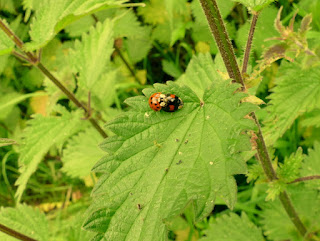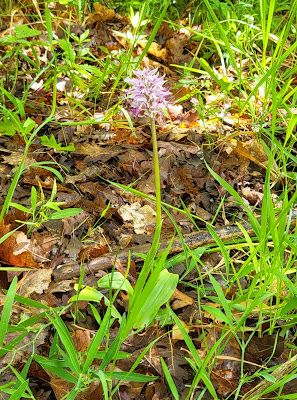A "lawn" area hosts four native orchid species: above centre a white form of Common-spotted orchid.
Click on any picture to enlarge it.
Above, left to right, a Fragrant orchid flowering for the third year; Common twayblade; and a couple of Southern Marsh orchids.
 |
| Fragrant orchid. Note its long spurs. |
 |
| Common Twayblade |
 |
| Southern Marsh orchid |
 |
| Ragged robin |
Hundreds of Cowslips have all gone to seed now as have dozens of Snakes' head fritillaries, below.
 |
| Bugle, an important food source for butterflies. |
Yellow Rattle, a hemi-parasitic annual, is firmly established throughout the garden.
Cow Parsley finally doing well.
Glorious shades of leaf colours: beech and maples.
Grass pollen is vital for certain beetle species
Decades old Yellow ant hill containing probably over 100,000 ants and reaching a metre down into the ground. Green woodpeckers regularly visit to feed on ants.
Fruit set on the pears and apple trees looks to be somewhat disastrous this year.
Common-spotted orchid reproducing vegetatively.
 |
| Vegetable bed with perennial spinach and self sown beetroot and "Spis bladene" Kale. |
 |
| Tree heather |
 |
| Bog garden next to a pond |
 |
| Royal fern on left. |
 |
| a formal area of hostas around a bay tree. |
Compost bin crawling with hundreds of Brandling worms
Nettles for Red Admirals etc., butterflies.
Holly flowers have set well
 |
| Fine Spear thistle |
Red Campion
 |
| Alliums |
This Wisteria is dying and a seedling has grown nearby and is flowering after a few years.
Two colour forms of Harlequin ladybirds mating. I have given up trying to control this foreign insect. So far native Seven-spot ladybirds are still doing well but some rarer natives have not been observed recently.
You enjoy nature walks, led by me, with
Haywards Heath u3a, nature walks group.


















































